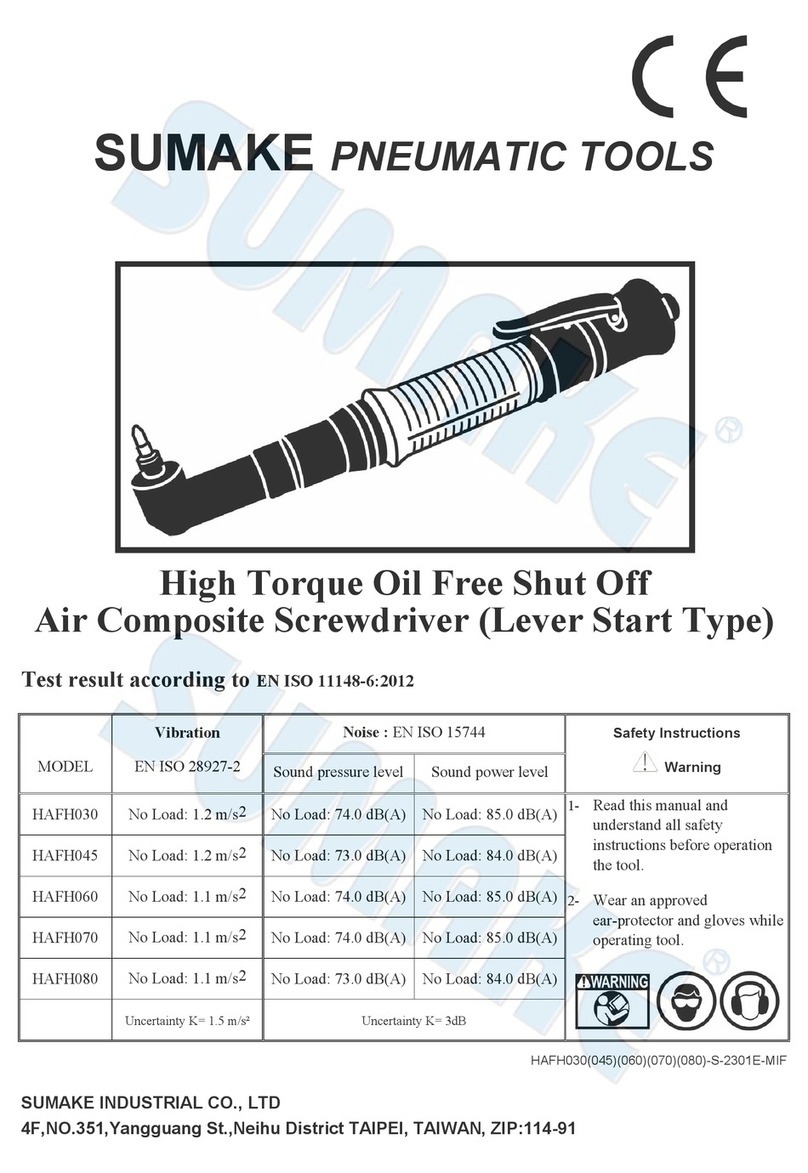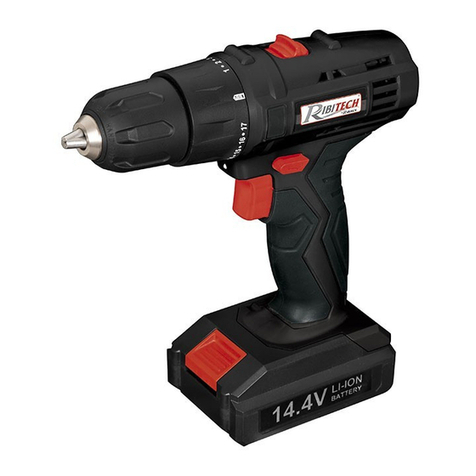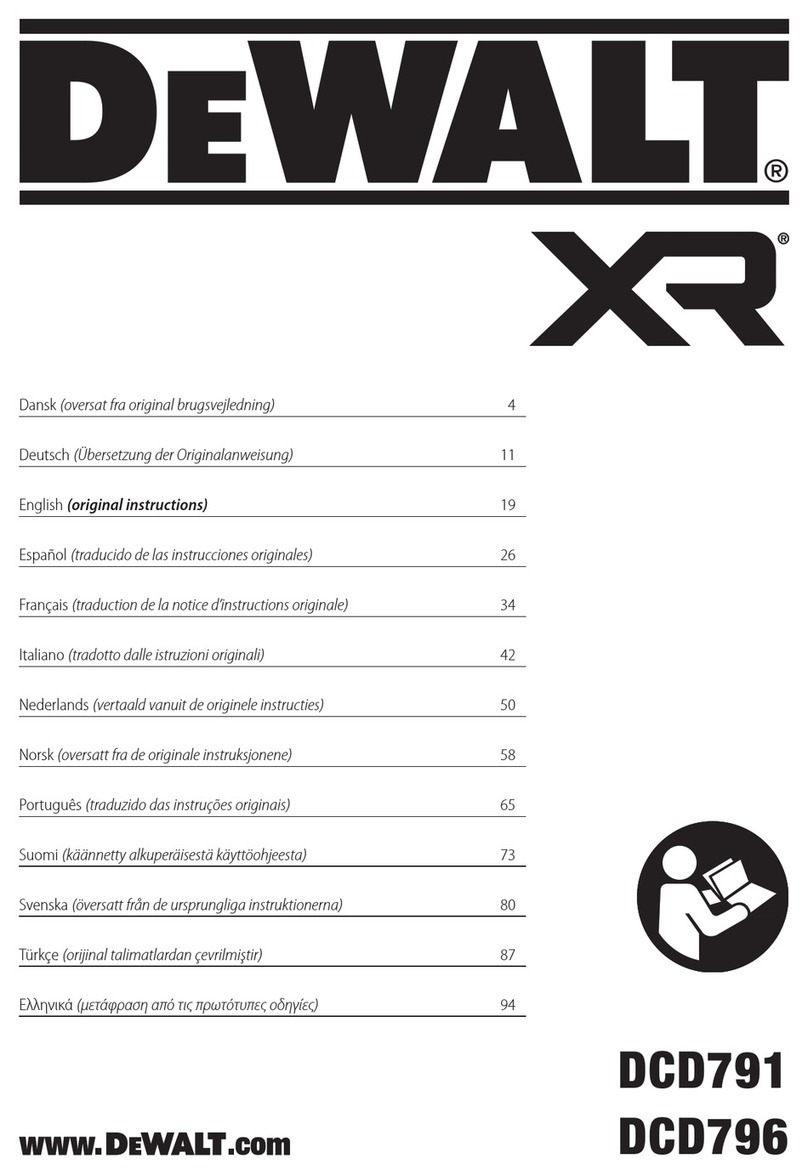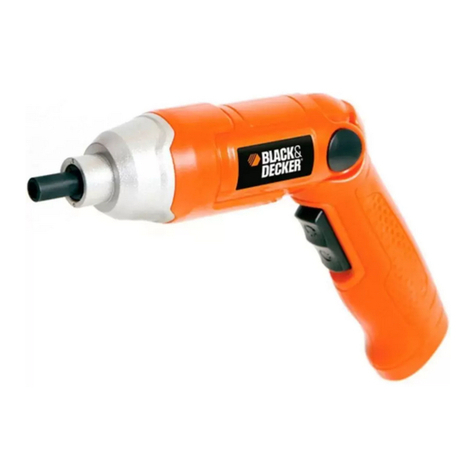Greatneck 80122 User manual

Owner’s Manual
4.8 V Cordless Pivoting Screwdriver
80122
CAUTION:
Before using this cordless
screwdriver or any of its
accessories, read this
manual and follow all
Safety Rules and
Operating Instructions.
• General Safety Rules
• Specific Safety Rules
and Symbols
• Functional Description
• Assembly
• Operation
• Maintenance
• Accessories
GreatNeck Tools, LLC Mineola, NY 11501
Rev. 07/10
/2010

2
SECTION
PAGE
SECTION
PAGE
Warranty ….……………………….
2
Product specifications …………..
3
Know your cordless
screwdriver …………………….
9
Accessories ……………………
10
Battery operated power tool
safety ………………………………
4–5
Carton contents……..………...
10–11
Cordless screwdriver safety ...…..
6
Assembly & operation ..………
12–14
Battery & charger safety ……….
6–7
Maintenance
…….……………..
15
Symbols …………………………..
8
Parts & service ..……..………..
16–17
WARNING: Some dust created by power sanding, sawing, grinding, drilling
and other construction activities contains chemicals known to cause cancer, birth
defects or other reproductive harm. Some examples of these chemicals are:
• Lead from lead-based paints
• Crystalline silica from bricks, cement and other masonry products
• Arsenic and chromium from chemically-treated lumber
Your risk from these exposures varies, depending on how often you do this type of
work. To reduce your exposure to these chemicals, work in a well-ventilated area
and work with approved safety equipment such as dust masks that are specially
designed to filter out microscopic particles.
WARRANTY
TABLE OF CONTENTS
ONE YEAR LIMITED WARRANTY
For one year from the date of purchase of this GreatNeck® product you
find any defect in material or workmanship, through normal usage and not
including standard wear, either return it to the place of purchase, or send it
to GreatNeck ® for repair or replacement at our discretion. In order to
obtain this service send your tool and proof of purchase, transportation pre-
paid, to GreatNeck ® Q.A. Dept, 3580 E. Raines Rd. #3, Memphis, TN
38118. This warranty gives you specific legal rights, and you may also have
other rights, which vary from state to state.
Please see our website for full warranty information.
For customer service call (866) - 458-2472
TABLE OF CONTENTS
!

3
SCREWDRIVER
Spindle speed ……………..
220 RPM (no load)
Battery ……………………...
4.8 V
Weight ……………………...
1 lb 2 oz (0.47 kg)
BATTERY & CHARGER
Battery Voltage ……………
4.8 V NiCad
Charger …………………….
3–5 Hour, Class 2
Charger Input ……………...
120 V AC, 60 Hz
Charger Output ……………
6 V DC, 400 mA
WARNING: To avoid electrical hazards, fire hazards or damage to the battery
charger, use proper circuit protection.
The battery charger is wired at the factory for 120 V operation. It must be connected
to a 120 V, 15 A time delayed fuse or circuit breaker. To avoid shock or fire, replace
power cord immediately if it is worn, cut or damaged in any way.
SPECIFICATIONS
!

4
GENERAL SAFETY RULES
WARNING: Read and understand
all instructions. Failure to follow all
instructions listed below may result in
electric shock, fire and/or serious personal
injury.
WORK AREA
Keep your work area clean and well-lit.
Cluttered benches and dark areas invite
accidents.
Do not operate power tools in explosive
environments, such as in the presence
of flammable liquids, gas or dust. Power
tools create sparks which may ignite the
dust or fumes.
Keep bystanders, children and visitors
away while operating the tool.
Distractions can cause you to lose control.
ELECTRICAL SAFETY
Double insulated battery chargers are
equipped with a polarized plug (one
blade is wider than the other). This plug
will fit in a polarized outlet only one way.
If the plug does not fit fully in the outlet,
reverse the plug. If it still does not fit,
contact a qualified electrician to install a
polarized outlet. Do not alter the plug in
any way. Double insulation eliminates the
need for the three wire grounded power
cord and grounded power supply system.
Use only the battery charger specified
for recharging the battery. This applies
to both battery-operated tools with
internal batteries and those with a
removable battery pack. A charger that
may be suitable for one type of battery may
create a risk of fire when used with another
battery.
Only use battery-operated tools with
their specifically designed battery pack.
Use of other batteries may create a risk of
fire.
Only use the charger in a standard
120 V, 60 Hz electrical outlet only.
Avoid body contact with grounded
surfaces such as pipes, radiators,
ranges and refrigerators. There is
increased risk of electric shock if your body
is grounded.
Don’t expose charger to rain or wet
conditions. Water entering the charger will
increase the risk of electric shock.
Do not abuse the cord. Never use the
cord to carry the charger or pull the plug
from an outlet. Keep cord away from heat,
oil, sharp edges and moving parts. Replace
damaged cords immediately. Damaged
cords increase the risk of electric shock.
When operating the charger outside, use
an outdoor extension cord marked “W-
A” or “W”. These cords are rated for
outdoor use and reduce the risk of electric
shock.
PERSONAL SAFETY
Stay alert, watch what you are doing and
use common sense when operating a
power tool. Do not use the tool while
tired or under the influence of drugs,
alcohol or medication. A moment of
inattention while operating power tools may
result in serious personal injury.
Use safety equipment. Always wear eye
protection. Dust mask, non-skid safety
shoes, hard hat or hearing protection must
be used for appropriate conditions.
BATTERY OPERATED POWER TOOL SAFETY
SAVE THESE INSTRUCTIONS FOR REFERENCE
!

5
PERSONAL SAFETY – cont’d
Dress appropriately. Do not wear loose
clothing or jewelry.
Contain long hair. Keep hair, clothing
and gloves away from moving parts.
Loose clothing, jewelry or long hair can be
caught in moving parts.
Avoid accidental starting. Be sure the
power switch is OFF before inserting
battery pack. Inserting the battery pack
with the switch ON or carrying tools with
your finger on the switch invites accidents.
Remove adjusting keys or wrenches
before turning the tool ON. A wrench or
key that is left attached to a rotating part of
the tool may result in personal injury.
Do not overreach. Keep proper footing
and balance at all times. Proper footing
and balance enables better control of the
tool in unexpected situations.
TOOL USE AND CARE
Use clamps or another practical method
to secure and support the workpiece on
a stable platform. Holding the work by
hand or against your body is unsafe and
may lead to loss of control.
Do not force the tool. Use the correct
tool for your application. The correct tool
will do the job better and safer at the rate
for which it is designed.
Do not use the tool if the power switch
does not turn ON or OFF. Any tool that
cannot be controlled with the switch is
dangerous and must be repaired.
Remove the battery and turn the switch
OFF before making any adjustments,
changing accessories or storing the
tool. Such preventive safety measures
reduce the risk of the tool starting
accidentally.
Store idle tools out of reach of children
and other untrained persons. Tools can
be dangerous in the hands of untrained
users.
Maintain tools with care. Keep cutting
tools sharp and clean. Properly
maintained cutting tools with sharp cutting
edges are less likely to bind and are easier
to control.
Check for misalignment or binding of
moving parts, breakage of parts and any
other condition that may affect the tool’s
operation. If damaged, have the tool
serviced before using. Many accidents
are caused by poorly maintained tools.
Use only accessories that are
recommended by the manufacturer for
your model. Accessories that are suitable
for one tool may become hazardous when
used on another tool.
SERVICE
Tool service must be performed only by
qualified personnel. Service or
maintenance performed by unqualified
personnel could result in risk of injury.
When servicing a tool, use only identical
replacement parts. Follow instructions
in the Maintenance section of this
manual. Use of unauthorized parts or
failure to follow Maintenance instructions
may create a risk of electric shock or injury.
BATTERY OPERATED POWER TOOL SAFETY

6
WARNING: For your safety, do not
plug in your charger, charge the battery
or operate the tool until you have read
and understood this Owner’s Manual.
Always use safety goggles or other
suitable eye protection.
Hold the tool by its insulated gripping
surfaces when driving screws in areas
where the screws may contact hidden
wiring. Contact with a “live” wire will make
exposed metal parts of the tool “live” and
can shock the operator. Do not drive
screws or break into existing walls or other
blind areas where electrical wiring may
exist. If this situation is unavoidable,
remove all fuses or disconnect all breakers
feeding the work area.
Secure the workpiece in a vice or with
clamps. Never hold it in your hand or
across your legs. The rotating action of
the screwdriver may cause the bit to come
loose from the screw and cause injury.
Never carry the cordless screwdriver
with your finger on the ON/OFF switch.
The tool is always in an “ON” condition
when the battery is charged.
Never hold the body of the cordless
screwdriver near the ON/OFF switch
while changing screwdriver bits.
Accidentally touching the ON/OFF switch
may start the tool and possibly cause an
injury.
Always use the correct shape of
screwdriver bit that matches the head of
the screw.
Always use the largest size screwdriver
bit that will properly fit into the head of
the screw.
Do not use worn or damaged
screwdriver bits. Worn or damaged
screwdriver bits will not drive the screw
properly and may jump out of the screw
head, causing possible injury.
Always install the screwdriver bit or
magnetic bit holder fully into the collet.
If not fully inserted, the bit or magnetic bit
holder may jump out of the collet and cause
damage to the workpiece or possible injury.
Never attempt to open the battery for
any reason. If the housing of the battery
breaks or cracks and allows leakage
through the handle, immediately
discontinue use and do not recharge the
cordless screwdriver.
Do not charge the battery if the tool is
wet or shows any evidence of battery
leakage.
Minor leakage from the battery may occur
under extreme use, charging or
temperature conditions. This does not
indicate a failure. If however, the outer
seal is broken and this leakage gets on
your skin, follow these steps:
1. Wash immediately with soap and
water.
2. Neutralize with a mild acid such as
lemon juice or vinegar.
3. If liquid gets into your eyes, flush
immediately with clean water for a
minimum of 10 minutes and seek
medical attention.
NOTE: The battery liquid is
20–35% solution of potassium
hydroxide.
!
BATTERY & CHARGER
SAFETY
CORDLESS
SCREWDRIVER SAFETY

7
WARNING: The Ni-Cad battery pack
is an integral part of the tool. If it will no
longer charge properly or is damaged,
the tool and battery must not be
discarded as household trash, burned or
thrown into water. The tool and battery
must be disposed of as hazardous
waste in accordance with all municipal
requirements.
Do not incinerate a discarded battery. It
can explode in a fire.
Do not use an extension cord. Plug the
charger cord directly into an electrical
outlet.
Charge the battery only with the charger
supplied with the cordless screwdriver.
Do not use the charger in wet or damp
conditions. It is intended for indoor use
only. Do not use the charger near sinks or
bathtubs. Do not immerse the charger in
water.
Do not allow the cord to hang over the
edge of a table or counter or touch hot
surfaces. The charger should be placed
away from sinks and hot surfaces.
Do not use charger to charge any
batteries other than the cordless
screwdriver battery. Other batteries may
explode.
Do not operate charger if cord or plug is
damaged. Replace damaged cord and
plug immediately.
Do not operate charger if it has received
a sharp impact, been dropped or
otherwise damaged in any way. Have a
qualified technician examine the charger
and repair it if necessary. Do not
disassemble the charger.
For best results, charge the battery when
the temperature range of the battery and in
the work area is 10–40°C (50–104°F).
Unplug the charger when not in use and
before cleaning or maintenance.
Do not abuse the cord. To reduce the risk
of damage to the electric cord or plug,
never carry the charger by the cord or yank
the cord to pull the plug. Always grasp the
plug and pull to disconnect. Always keep
the cord away from heat, oil and sharp
edges.
BATTERY & CHARGER SAFETY
!

8
V
volts
A
amperes
Hz
hertz
W
watt
kW
kilowatts
microfarads
L
litres
kg
kilograms
H
hours
N/cm2
newtons per square
centimetre
Pa
pascals
Min
minutes
S
seconds
alternating current
three-phase alternating
current
three-phase alternating
current with neutral
direct current
no load speed
alternating or direct current
class II construction
splash proof construction
watertight construction
protective earthing at
earthing terminal, Class I
tools
revolutions or
reciprocations per minute
diameter
off position
arrow
warning symbol
WARNING: Some of the following symbols may be used on your
tool. Please study them and learn their meaning. Proper interpretation
of these symbols will allow you to operate the tool better and safer.
!
SYMBOLS
This symbol designates that
this tool is listed with both
Canadian and U.S.
requirements by Underwriters
Laboratories.
61TN
E213739
JD5002

9
KNOW YOUR CORDLESS SCREWDRIVER
Collet
Charger
receptacle
Forward/Reverse
switch
Pivoting
handle
Charging
indicator light
Battery
charger
Charger plug

10
ACCESSORIES & CARTON CONTENTS
CARTON CONTENTS
AVAILABLE ACCESSORIES
WARNING: Use only accessories
recommended for this cordless
screwdriver. Follow all instructions that
accompany this tool. Use of improper
accessories may cause injury to the
operator or damage to the tool.
Do not use any accessory unless you have
completely read the instructions and/or
Owner’s Manual for that accessory.
WARNING: If any part is missing
or damaged, do not plug the charger
into the power source until the missing
or damaged part is replaced.
Carefully unpack the cordless screwdriver.
Compare against the “Cordless Screwdriver
Components” chart at right.
NOTE: See illustration of components on
Page 11.
WARNING: To avoid fire or toxic
reaction, never use gasoline, naphtha,
acetone, lacquer thinner or similar
highly volatile solvents to clean the tool.
!
!
!
CORDLESS SCREWDRIVER
COMPONENTS
KEY
DESCRIPTION
QTY
A
Cordless screwdriver
1
B
Magnetic hex bit
extension
1
C
Screwdriver bits
#0
#1 (x2)
#2 (x2)
#3
6
D
Screwdriver bits
#0
#1 (x2)
#2 (x2)
#3
6
E
Screwdriver bits
3 mm
4 mm
4.5 mm
5 mm
6 mm
7 mm
6
F
Screwdriver bits
#0 posi-drive
#1
#2
#3
4
G
Battery charger
1
Owner’s manual
1

11
CARTON CONTENTS

12
CHARGING THE BATTERY
1. Place the cordless screwdriver near a
120 V, 60 Hz electrical outlet.
2. Insert the battery charger plug (1) into
the charger receptacle (2) in the
handle of the cordless screwdriver (3)
(Fig. 1).
3. Plug the battery charger (4) into a
120 V 60 Hz wall receptacle.
NOTES:
a) The red indicator light (5) in the handle
will turn ON, indicating a positive
connection with the charger.
b) The red indicator light will remain ON
until the charger is disconnected.
c) A new battery or one that is completely
run down should be charged for 5 hours.
After normal use, a battery should be fully
charged in about 3 hours or more.
d) If the battery does not charge properly,
check to make sure the electrical outlet is
“live” and that the temperature range in the
work area is between 10–40°C (50–104°F).
INSTALLING SCREWDRIVER BITS
WARNING: Never hold the body of
the cordless screwdriver near the switch
while changing screwdriver bits.
Accidentally touching the switch may
start the tool and possibly cause an
injury.
1. Select an appropriate screwdriver bit
that fits the head of the screw being
driven.
NOTES:
a) Use the largest size screwdriver bit
that will properly fit the screw head.
b) Make sure the screwdriver bit is in
good condition and is neither damaged
nor worn.
2. Insert the screwdriver bit (1) fully into
the screwdriver collet (2) (Fig. 2).
NOTES:
a) Make sure the screwdriver bit is fully
inserted into the collet.
b) If required, insert the magnetic hex
bit extension (3) into the collet first and
then insert the screwdriver bit fully into
the magnetic hex bit extension.
!
ASSEMBLY & OPERATION
Fig. 1
Fig. 2

13
FORWARD/REVERSE SWITCH
The cordless screwdriver is equipped with a
convenient switch that functions as both an
ON/OFF switch and FORWARD/REVERSE
switch.
1. To drive screws, press the right hand
side of the switch (1) (Fig. 3). To turn
the switch OFF, release the switch.
2. To remove screws, press the left hand
side of the switch (2).
PIVOTING HANDLE
The handle of the cordless screwdriver is
designed to pivot to various angles. This
feature allows you to configure the tool for
easier access in hard to reach locations. It
also makes it easier to apply extra torque in
manual mode.
To pivot the handle, simply “bend” the tool
in the middle to the appropriate angle (1)
(Fig. 4)
PREPARING SCREW HOLES
It is important to prepare screw holes
before attempting to fasten two pieces of
wood together. Proper preparation will
make screws drive easier and prevent
misaligned components, stripped screw
heads, splitting and separating of wood
components.
1. Clamp components that are to be
screwed together in their desired
position (Fig. 5).
2. Drill a pilot hole (1) through the outer
piece (2) and into the inner piece (3).
Drill hole 2/3 the diameter of the
smooth portion of the screw shank.
NOTE: If the wood is soft, drill the hole
2/3 the length of the screw. If the wood
is hard, drill the hole the full length of
the screw.
3. Remove the clamp from the two pieces
to be screwed together.
4. Enlarge the hole (1) in the outer piece
(2) so that it is the same size as the
smooth portion of the screw shank
(Fig. 6).
5. If using a flat head screw, counter-sink
the hole (4) so the head of the screw
will be flush with the surface when fully
driven into place.
ASSEMBLY & OPERATION
Fig. 3
Fig. 4
Fig. 5
Fig. 6

14
DRIVING SCREWS
When driving screws, care must be taken to
use the bit that correctly fits the head of the
screw being driven. Make sure you use the
largest bit size that will properly fit into the
head of the screw. The bits must also be in
good condition and not worn so they will
drive screws without slipping out of the
screw head.
1. Select the correct screwdriver bit for
the screw being driven.
NOTE: Use the magnetic hex bit
extension if longer reach is required.
2. Insert the bit fully into the screwdriver
collet (1) (Fig. 7).
3. Pivot handle to a comfortable position
(2).
4. Insert the screwdriver bit fully into the
screw head (3).
5. While holding the screwdriver firmly
against the screw, press the right hand
side of the switch to start the
screwdriver and drive the screw.
6. When the screw is driven as far as
possible, release the switch and the
screwdriver will stop.
7. When the switch is released and the
screwdriver stops turning, the spindle
will automatically lock. Fully tighten the
screw by manually rotating the
screwdriver handle in a clockwise
direction (4).
ASSEMBLY & OPERATION
WARNING:
Have you read “BATTERY
OPERATED POWER TOOL SAFETY”,
“CORDLESS SCREWDRIVER
SAFETY”, “BATTERY & CHARGER
SAFETY” and “SYMBOLS” on pages
4, 5, 6, 7 & 8 of this Manual? If not,
please do so now before you operate
this tool. Your safety depends on it!
Every time you use the screwdriver
you should verify the following:
1. Screwdriver bit is the correct
type & size, not worn and not
damaged in any way.
2. Workpiece is properly secured.
3. Safety glasses are being worn.
Failure to follow these safety rules
can greatly increase the chances of
injury.
!
Fig. 7

15
GENERAL
WARNING: When servicing, use
only identical replacement parts. Use of
any other part may create a hazard or
cause product damage.
DO NOT use solvents when cleaning
plastic parts. Most plastics are susceptible
to damage from various types of
commercial solvents and may be damaged
by their use. Use a clean cloth to remove
dirt, dust, oil, grease etc.
WARNING: Do not at any time
allow brake fluids, gasoline, petroleum-
based products, penetrating oils, etc. to
come in contact with plastic parts. They
contain chemicals that can damage,
weaken or destroy plastic.
DO NOT abuse power tools. Abusive
practices can damage the tool as well as
the workpiece.
WARNING: DO NOT attempt to
modify tools or create accessories not
recommended by the manufacturer. Any
such alteration or modification is
misuse and could result in a hazardous
condition leading to possible serious
injury. It will also void the warranty.
LUBRICATION
All of the bearings in this tool are lubricated
with a sufficient amount of high-grade
lubricant for the life of the unit under normal
conditions. Therefore, no further lubrication
is required.
!
!
!
MAINTENANCE

16
PARTS DIAGRAM – MODEL 80122
34
33
14
12
2
3
4
5
6
732
22
21
20
26
25
24
23
19
18
17
16
15
13
11
10
9
8
27
28
29
30
31
1

17
WARNING: When servicing, use only GreatNeck®replacement parts. Use of
any other parts may create a HAZARD or cause damage to your power tool.
Any attempt to repair or replace electrical parts on this power tool may create a
hazard unless repair is performed by a qualified technician.
Always order by PART NUMBER
Key #
Part #
Part Name
Quantity
1
80122-1
Magnetic block
1
2
80122-2
Retaining ring
1
3
80122-3
Output shaft
1
4
80122-4
Connecting bar
1
5
80122-5
Self lubricating bearing
1
6
80122-6
Gear housing
1
7
80122-7
Clamping plate
1
8
80122-8
Driven block
1
9
80122-9
Pin
6
10
80122-10
Positioning ring
1
11
80122-11
Ring gear
1
12
80122-12
Driving block
1
13
80122-13
Powder metal planet gear
3
14
80122-14
Planet carrier
1
15
80122-15
Plastic planet gear
3
16
80122-16
Motor gear
1
17
80122-17
Screw M2.5X4.5
2
18
80122-18
Flange
1
19
80122-19
Motor
1
20
80122-20
Screw ST2.5X8
4
21
80122-21
Connecting plate
2
22
80122-22
Ball
4
23
80122-23
PCB for switch
1
24
80122-24
Switch
1
25
80122-25
Battery pack
1
26
80122-26
Charge PCB
1
27
80122-27
Left motor housing
1
28
80122-28
Screw ST2.9x16
9
29
80122-29
Screw ST2.9x25
1
30
80122-30
Left grip housing
1
31
80122-31
Right motor housing
1
32
80122-32
Decoration button
1
33
80122-33
Right grip housing
1
34
80122-34
Screw ST2.5x8
2
!
PARTS LIST – MODEL 80122
Table of contents
Other Greatneck Power Screwdriver manuals
Popular Power Screwdriver manuals by other brands

Black & Decker
Black & Decker 9018-1 instruction manual

Black & Decker
Black & Decker KC460LN Original instructions

Titan
Titan TTO054DDH Safety and operating manual
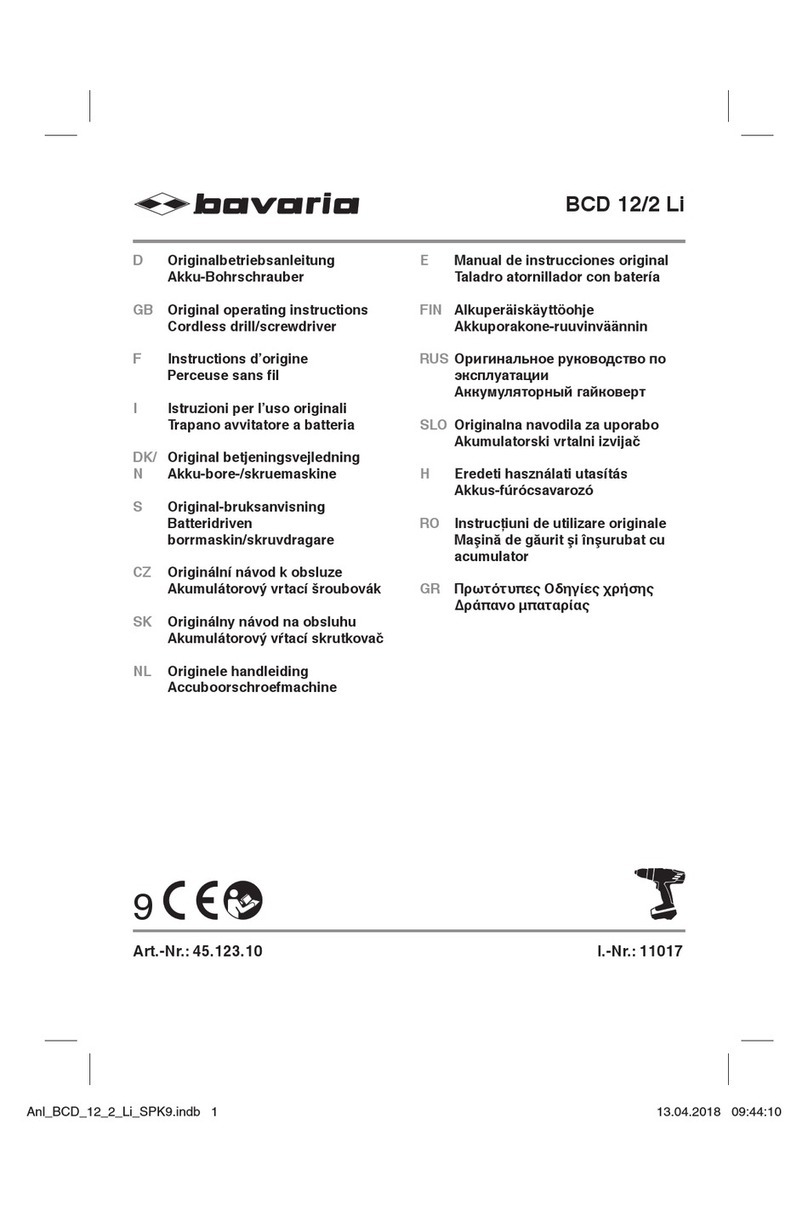
Bavaria
Bavaria BCD 12/2 Li Original operating instructions
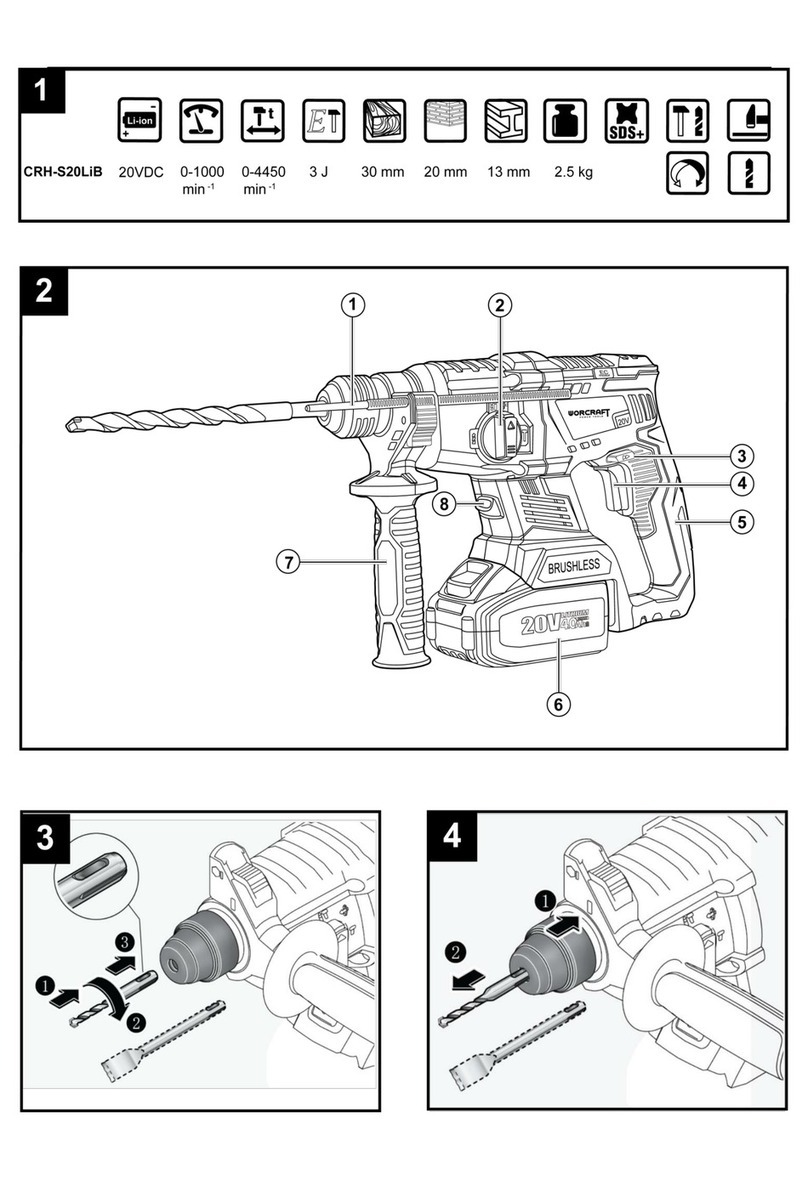
Worcraft
Worcraft CRH-S20LiB manual
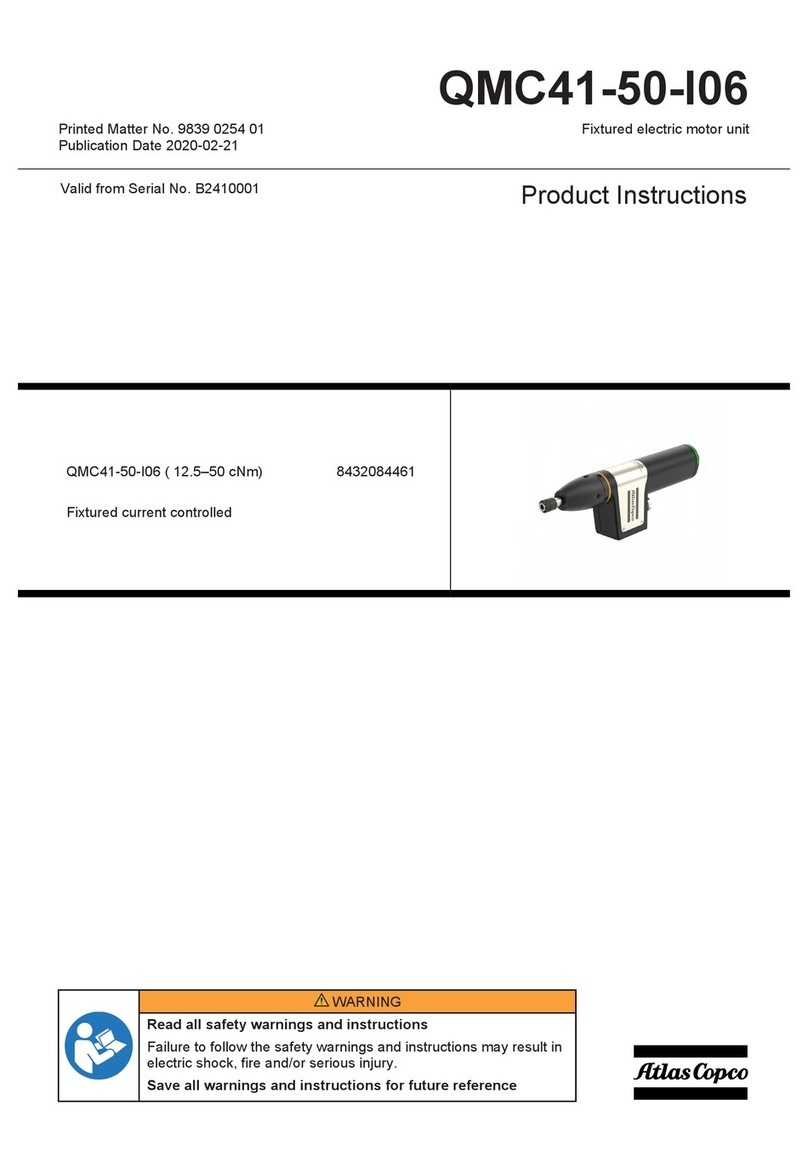
Atlas Copco
Atlas Copco QMC41-50-I06 Product instructions

Bosch
Bosch GSR Professional 185-LI Original instructions
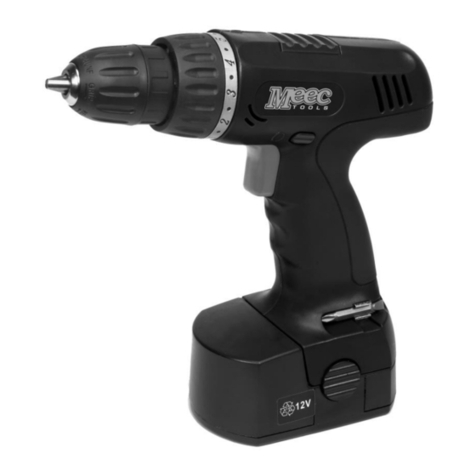
Meec tools
Meec tools 060-205 operating instructions
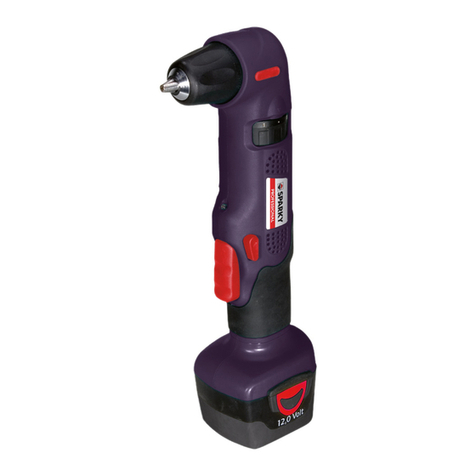
Sparky Group
Sparky Group BAR 12E Instruction Мanual
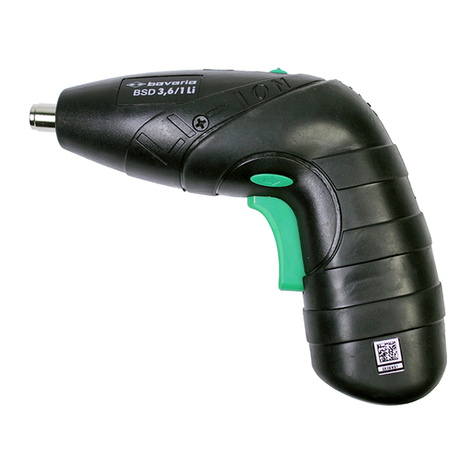
EINHELL Bavaria
EINHELL Bavaria BSD 3,6/1 Li operating instructions
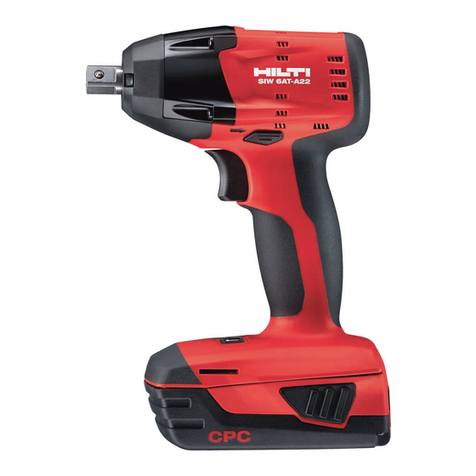
Hilti
Hilti SIW 6 AT-A22 user manual
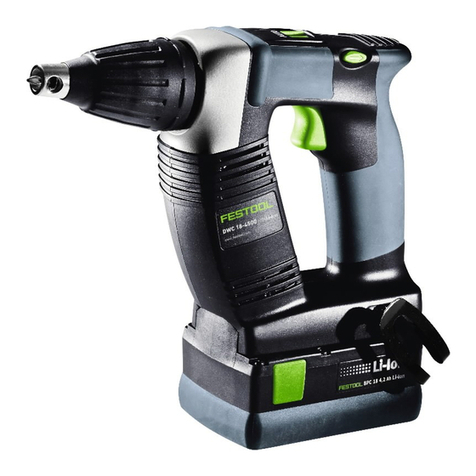
Festool
Festool DWC 18-2500 operating manual


